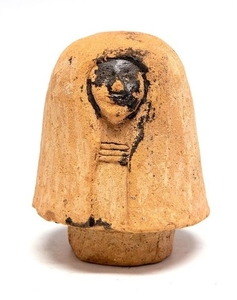Ancient Egyptian Terracotta Canopic Jar Lid of Imsety - 11.5×8×8 cm - (1)
Egyptian Terracotta Jar Lid of Imsety, 2655-2055 BC. A fascinating early Middle Kingdom Canopic Jar Lid of the human headed Imsety; Guardian of the liver. Canopic Jars were used by the Egyptians during the mummification process to store and preserve the viscera of their owner for the afterlife. The organs of the deceased were protected by the four sons of Horus, Imsety, Duamutef, Hapi and Qebehsenuef. The four sons of Horus were personifications of the four canopic jars, which accompanied mummified bodies. Canopic jars were made as early in Egyptian history as the Old Kingdom and continued all the way through until the Ptolemaic Period, where the Egyptians began to wrap the organs and place with the mummified body. Ref: A similar example can be seen at Petrie Museum, Item no: UC 30103. 11. 5cm. Provenance: Ex. Private Collection of 1920's collector Hans Moller Hansen Collection, Denmark, acquired legally in the late 1920's when visiting Egypt. Declaration of provenance: All provenance details are supplied by the vendor (consignor) – Hansons Auctioneers and Valuers supply a Certificate of Authenticity with all antiquities sold showing authenticity. Provenance and known details recorded on this. The Supplier warrants that he/she obtained this lot in a legal manner. Provenance statement seen by Catawiki. Important information. The seller guarantees that he is entitled to ship this lot. The seller will take care that any necessary permits will be arranged. The seller will inform the buyer about this if this takes more than a few days
[ translate ]View it on
Estimate
Time, Location
Auction House
Egyptian Terracotta Jar Lid of Imsety, 2655-2055 BC. A fascinating early Middle Kingdom Canopic Jar Lid of the human headed Imsety; Guardian of the liver. Canopic Jars were used by the Egyptians during the mummification process to store and preserve the viscera of their owner for the afterlife. The organs of the deceased were protected by the four sons of Horus, Imsety, Duamutef, Hapi and Qebehsenuef. The four sons of Horus were personifications of the four canopic jars, which accompanied mummified bodies. Canopic jars were made as early in Egyptian history as the Old Kingdom and continued all the way through until the Ptolemaic Period, where the Egyptians began to wrap the organs and place with the mummified body. Ref: A similar example can be seen at Petrie Museum, Item no: UC 30103. 11. 5cm. Provenance: Ex. Private Collection of 1920's collector Hans Moller Hansen Collection, Denmark, acquired legally in the late 1920's when visiting Egypt. Declaration of provenance: All provenance details are supplied by the vendor (consignor) – Hansons Auctioneers and Valuers supply a Certificate of Authenticity with all antiquities sold showing authenticity. Provenance and known details recorded on this. The Supplier warrants that he/she obtained this lot in a legal manner. Provenance statement seen by Catawiki. Important information. The seller guarantees that he is entitled to ship this lot. The seller will take care that any necessary permits will be arranged. The seller will inform the buyer about this if this takes more than a few days
[ translate ]


